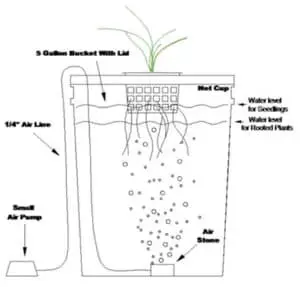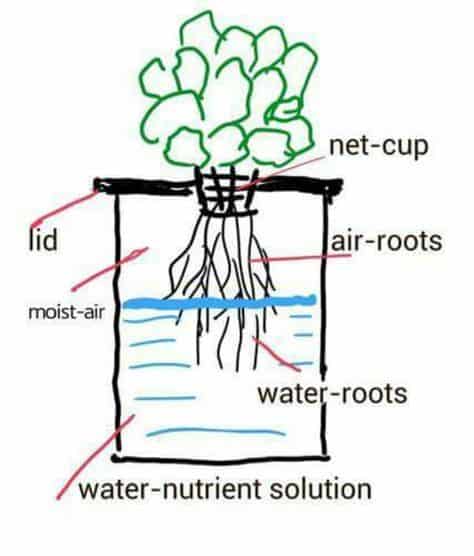Last week, I had my DWC system set up. Surprisingly, I didn’t know what the water level required for my Lettuce to grow healthy. So, after using the help of a friend who happens to be a hydroponic grower for nearly eight years, I finally found the answer.
So what is the exact water level of DWC? The water level should be high enough so that only the lower part of the roots can be touching it for nutrient uptake. However, it would help if the water level does not reach the point that it will completely submerge the whole seedling and the media.

Many new growers make the mistake of increasing the water levels until it reaches the net pot. Not only will it kill the plant immediately, but it will also lower your confidence as a grower and affects your ability in growing future hydroponic crops.
How The Water Level Can Boost Your Plant’s Growth?
Maintaining the water level of your system is crucial, especially in the early part of your plant’s growth cycle. Your water level should be high to a level where the lower ends of the root are dangling in the solution.
If you did like every beginner and completely submerge the net pot with the roots and seedlings, you could be risking the plant’s life due to various reasons such as suffocation from lack of oxygen and weak root growth.
By leaving the upper part of the root exposed to air, you will stimulate the roots to form what are called air roots, which will absorb oxygen from the surrounding air. These roots can save the plant’s life when oxygen levels drop in the water.
Air roots are a special feature of the Kratky method. Unlike the DWC system, this method doesn’t require air pumps to oxygenate the nutrient solution. Most people often confuse DWC and Kratky systems as being the same which is completely wrong. You can check out this article(Kratky vs DWC) where I wrote about the exact differences and which system is better for growing plants.

Oxygen levels can decline due to many reasons. Your air pump might break suddenly, or you can be hit by a power outage that will risk your plant’s life. Moreover, you might have chosen a weak air pump that doesn’t provide enough oxygen for the roots. As a result, your plants will undergo a gradual health deterioration, which will eventually lead to death.
Another benefit of using such a water level is the stimulation of root growth. Plants are one of the fastest-adapting living organisms.
When you’re leaving only the lower root end in the water, the roots will grow at a much quicker rate in an attempt to increase their accessibility to the water and nutrients source. This will help boost the plant’s initial growth rate due to the increased uptake of water and minerals.
After your plant’s root growth has reached its peak, you must be able to keep up with the increased water uptake. Many new growers think that they can top up the solution every once in a while and have the same growth rate as the one they experienced in the beginning. They are entirely wrong.
You have to keep the water level of your DWC system well monitored to avoid any coincidence that might lead to your plant’s death. As I have mentioned before, plants consume a lot more water as they grow compared to their early stages. This requires more frequent checkup’s throughout the day.
I know you might think that a couple of checkups now and then throughout the day is not a big deal, but trust me, it will become a huge headache as your plant grows day after day. I passed through this hassle with the little help of an ultrasonic liquid depth detector.
This detector monitored my water level continuously throughout the day, and whenever the level gets below a certain set level, it gives me an alarm to the top of the water again. Moreover, I can check the water level directly from the connected LCD bar screen outside the system without having to remove the upper lid several times throughout the day. You can check it out here.
The Right Topping-Up Method For Hydroponics
Plants use water for their photosynthesis process so that they can grow and yield crops. This leads to a gradual decline in the water level. As a result, every grower should track their plant’s water level daily.
As I mentioned before, when it comes to topping up the water, most growers use the wrong technique. Most growers forget the fact that the plant uses nutrients as well as water. Despite the relatively lower uptake rate of nutrients compared to water, nutrient concentrations decline over the growth cycle of the plant.
When you top up the solution with water every time throughout the plant’s life cycle, you will be left with a solution of nutrients that is heavily diluted with water. Not only will it inhibit the plant’s growth, but also it will lead to the death of the plant as the only source of nutrients for them in hydroponics is the nutrient solution.
Instead, you should flush and completely replace the old solution with a new, nutrient-rich solution. After my friend has done many experiments, he has concluded that newbie growers should replace the nutrient solution whenever the total volume of their topped-up water reaches 50% of the volume of the original nutrient solution.
On the other hand, the water level can have a faster-than-average decline rate, which often happens due to the rapid pace of evaporation. For most people, it will not be a massive problem as they can top it up when needed, but some busy growers, don’t have the time to check up on the water level continually. As a result, their nutrient solution will turn soon into a concentrated salt solution that can kill the plant in hours.

How to Prevent Water Evaporation In Hydroponics
When the plant is exposed to the sun for photosynthesis, some thermal energy will transmit from light rays into the water solution. This results in a marked increase in temperature that will increase the evaporation rate and at the same time, affect the plant’s roots.
You can easily avoid that by using opaque containers or covers to prevent sunlight from passing through the solution. This will not only lower the temperature and decrease evaporation, but it will also inhibit algae growth, which will require a tedious flushing process for removal.

In some cases, the high water temperature is caused by heat transmission from the air pump through air bubbles. The pump’s high temperature can be easily cooled down through different methods such as:
- Directing a small cooling fan to the pump.
- Placing the pump near an AC.
- Placing the Pump in front of an opened window to be cooled by outside air.
Some tropical places continuously have a high outside temperature that is transmitted easily to water. Growers like to use water bottles as a trick in this situation.
You can freeze or refrigerate closed bottles that are filled with water and add them to the solution until they meltdown and replace them with new ones. Remember not to open the water bottle in the solution to prevent any source of water contamination or PH disturbance.
What is The Water Level of a Seedling in DWC?
So, what is the ideal water level for seedlings in a DWC system? The water level should be just below the net cup that holds the seedling. This helps ensure that the plant’s roots are partially submerged in the water, allowing them to absorb the necessary nutrients while preventing the stem and leaves from sitting in water and potentially leading to rot.
It’s crucial to maintain this water level throughout the seedling’s growth cycle, as any significant fluctuations can cause stress to the plant and hinder its development. One way to ensure a consistent water level is by checking the water level daily and topping it up as needed.
Another essential factor to consider when growing seedlings in a DWC system is the nutrient solution’s strength. Seedlings are delicate and require less nutrient concentration than mature plants. A good rule of thumb is to start with a nutrient solution that is half the recommended strength for mature plants and gradually increases as the seedling grows.
How Many Gallons Does a DWC Plant Need?
So, how many gallons does a DWC plant need? The answer depends on the plant’s size, stage of growth, and the size of the container used. As a general rule of thumb, a mature DWC plant requires about one gallon of water per pound of plant weight. For example, a five-pound plant would require around five gallons of water.
It’s important to note that younger plants require less water than mature plants. For seedlings, the water level should be just below the net cup, as we discussed in a previous article. As the plant grows, the water level can be increased, so it covers the base of the net cup fully.
Another factor to consider when determining the appropriate amount of water for your DWC plants is the size of your container. Larger containers can hold more water, which can help maintain a more stable water temperature and nutrient solution concentration. However, larger containers can also lead to more significant fluctuations in water level, so it’s essential to monitor the water level frequently and adjust as needed.
Conclusion
Maintaining the proper water level in your DWC system is crucial for the health and growth of your plants. With the right tools and knowledge, determining the exact water level can be a simple and straightforward process.
The lower part of the roots should be partially submerged in the solution for nutrient uptake. However, it would help if the water level does not reach the point that it will completely submerge the whole seedling and the media.
By keeping an eye on factors that can affect water levels, such as temperature and nutrient level, you can ensure that your plants are getting the right amount of water they need to thrive.
So, whether you’re a seasoned DWC grower or just starting out, taking the time to maintain the proper water level is a small but essential step in achieving a successful harvest. With these tips and tricks, you’re well on your way to growing healthy and happy plants in your DWC system.
We hope this article has been helpful and informative, and we encourage you to put these practices into action in your own DWC system. Happy growing!



Thanks for the info. The most helpful site I have found. Where I live we grow……. ( :
Thank you sir for your valuable comments. Am newbie here. So it would be a simple question. I’ve started with beans plant. I would like to know why roots getting dry. Roots I mentioned is root between water ands net cups. I don’t use air pump. Daily twice I stir the water thoroughly for oxygenating.
There is a huge chance that your beans plant is suffering from root rot, especially when you are not running any kind of air pump to support the oxygenation process. Your plant roots need oxygen and stirring the nutrient solution is just not enough. Try getting one of these cheap air pumps available on amazon, they will do the trick.
How do I know my water level if the toots have not come out the bottom of the net pot yet? I don’t want to much water but then again I don’t want to little water
when u 1st put the net cup in the dwc & there are no roots dangling how do the roots get water if u cant submerge the net cup?
What should your ppm levels b in each week of growth
Top water your seedlings until the roots hit the water.